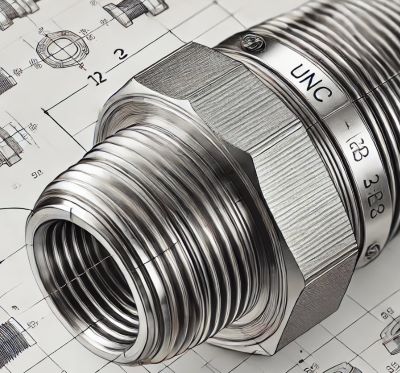When it comes to fastening components, selecting the right thread standard is essential. The thread standard you choose can significantly impact the strength, durability, and overall performance of your assembly. One of the most common thread standards used in the United States and other countries is the Unified National Coarse (UNC) thread.
In this blog post, we will explore the advantages and disadvantages of UNC threads, compare them to other thread standards, and help you decide if they are the best choice for your needs.
What Are UNC Threads?
UNC threads are a type of unified thread, which means they are standardized by the American National Standards Institute (ANSI). They are characterized by their coarse pitch, which is the distance between the peaks of adjacent threads. This coarse pitch makes UNC threads relatively easy to install and remove, even in less-than-ideal conditions.
The UNC thread standard is defined by a series of numbers, such as UNC 1/4-20. The first number, 1/4, represents the nominal diameter of the thread in inches. The second number, 20, represents the number of threads per inch. UNC threads are available in a wide range of sizes, from very small to very large.
Key Features of UNC Threads Coarse Pitch and Wide Applications
One of the key features of UNC threads is their coarse pitch. This makes them relatively easy to install and remove, even in less-than-ideal conditions. UNC threads are also available in a wide range of sizes, making them suitable for a variety of applications.
Common Applications of UNC Threads
UNC threads are used in a wide variety of applications, including:
➡️ Industrial use cases: heavy-duty machinery and construction
➡️ Everyday applications: tools, appliances, and home repairs
Industrial Use Cases Heavy-Duty Machinery and Construction
In industrial settings, UNC threads are commonly used in heavy-duty machinery and construction. The coarse pitch of UNC threads makes them resistant to stripping and breakage, even under high loads.
Everyday Applications Tools, Appliances, and Home Repairs
UNC threads are also commonly used in everyday applications, such as tools, appliances, and home repairs. The coarse pitch of UNC threads makes them easy to install and remove, even with basic tools.
Comparing UNC Threads to UNF Threads
Unified Fine Threads Versus Coarse Threads Key Differences
Another common thread standard is the Unified National Fine (UNF) thread. UNF threads have a finer pitch than UNC threads, which makes them more resistant to vibration and loosening. However, UNF threads can be more difficult to install and remove, especially in less-than-ideal conditions.
Check out this blog to have a deeper understanding on the difference between UNC and UNF
➡️ Understanding UNC vs UNF Differences
When to Choose UNF Threads Over UNC Threads Precision Needs
UNF threads are often used in applications where precision and vibration resistance are critical, such as aerospace and automotive components.
UNC Threads Versus Metric Threads
Metric threads are another common thread standard. They are defined by their diameter in millimeters and their pitch in millimeters. Metric threads are becoming increasingly popular, especially in international markets.
Why UNC Threads Are Preferred in Certain Industries
UNC threads are still preferred in some industries, such as construction and manufacturing, due to their compatibility with existing equipment and tooling.
Advantages of Using UNC Threads
There are several advantages to using UNC threads, including:
➡️ Easier installation in soft materials or tapped holes
➡️ Higher resistance to stripping and quick assembly
Disadvantages of UNC Threads to Consider
However, there are also some disadvantages to using UNC threads, such as:
➡️ Limited precision in high-stress environments
➡️ Not suitable for tight spaces or small components
Choosing the Right Thread Standard for Your Needs
When choosing a thread standard for your project, it is important to consider the specific requirements of your application. Factors such as the strength, precision, and vibration resistance of the threads are all important considerations.
Evaluating Project Requirements Strength Versus Precision
If you need a thread that is strong and easy to install, UNC threads may be a good choice. However, if you need a thread that is precise and resistant to vibration, UNF threads may be a better option.
Practical Examples to Help You Decide UNC or Others
Here are some practical examples to help you decide which thread standard is right for you:
➡️ If you are building a piece of heavy-duty machinery, UNC threads may be a good choice.
➡️ If you are manufacturing a precision instrument, UNF threads may be a better option.
➡️ If you are working on a project with tight tolerances, metric threads may be the best choice.
Tips for Working with UNC Threads
Here are some tips for working with UNC threads:
➡️ Select the correct tools for installation and maintenance
➡️ Avoid overtightening the threads, which can lead to stripping or breakage
➡️ In order to minimize friction and avoid galling, use a thread lubricant.
Common Mistakes to Avoid When Using UNC Threads
Some common mistakes to avoid when using UNC threads include:
➡️ Using the wrong size or type of thread
➡️ Overtightening the threads
➡️ Not using a thread lubricant
Conclusion
Choosing the right thread standard for your project is essential for ensuring a strong and reliable assembly. By understanding the advantages and disadvantages of different thread standards, you can make an informed decision that will meet the specific needs of your application.
By understanding thread standards, you can improve the success of your projects by selecting the right fasteners for the job. This can help to prevent costly mistakes and ensure that your assemblies are strong and durable.
I hope this blog post has helped you to better understand UNC threads and how to choose the right thread standard for your needs. If you have any questions, please feel free to leave a comment below.
Post time: Jan-16-2025


